Wellbore re-entries and repairs: practical guidelines for cementing new casing inside existing casing
By Arthur S Metcalf and Donald L Purvis, BJ Services, and Shannon Stilwell, Walsh Petroleum
Whether a well is being re-entered after having been abandoned for some time or it simply needs to be repaired to be functional, many operators choose to cement a new smaller outside diameter (OD) casing string inside the old one. Previously abandoned wells have been re-evaluated and found to respond to fracture stimulation using newer methods; however, to accomplish this, the casing string must have integrity. Casing integrity is also of significance in view of state regulations.
The challenges of this type of operation are many. One is to avoid excessive surge pressures while running the new casing. This means that on many occasions, running rates of the casing may have to be approximately 1 ft/sec. Excessive surge pressure can fracture a formation of interest, making it difficult to obtain the desired production rates.
Another challenge is to match casing size for stimulation with achieving successful cement isolation of an annular space. Smaller-diameter casing will result in increased friction pressure and therefore treatment rate restrictions. Stimulation may require multistage completions to be effective. The increased cost of stimulation must be balanced with the need to achieve cement isolation.
Presented here are the analyses of various scenarios examining fracture gradient, old casing burst pressures, fracture stimulation rates and pressures and equivalent circulating densities of potential cement slurries. Case histories are used to illustrate these scenarios and present situations in which the cost of the cement pumped versus what should have been required is compared. Also presented are the operational and cost differences regarding stimulation as a function of casing internal diameter. In one case, over three times the quantity of cement that should have been necessary to achieve circulation back to surface was pumped without circulating.
BACKGROUND
Several situations exist where a smaller OD casing is cemented inside an existing casing: re-entry into a previously abandoned wellbore, repair of an existing casing or to facilitate drilling deeper. Re-entry and repair are of primary concern since these typically involve a smaller annular space between the two strings of casing. The concerns are, first, getting a good cement job and, second, having sufficient internal diameter (ID) to facilitate future stimulation treatments.
In the last few years, re-entries have been significant in West Texas and southeastern New Mexico. They provide the opportunity of avoiding excess drilling costs to obtain an economically producing property. However, the ultimate goal is to have a producing well with a good hydraulic seal across all rock strata and therefore control of all fluid movements downhole.
This is only accomplished by filling all of the annular space between the old and new casings with cement. Many of these re-entries require hydraulic fracture stimulation to create an economic producer. To accomplish this, operators maximize the flush joint liner string diameter. This minimizes the annular space between the existing casing and the flush joint liner. When cementing these narrow annular spaces, the excess of cement pumped – the amount over what should be required between two casing strings – is much greater than expected. This has often been greater than the excess of a primary cement job where casing is being cemented in a newly drilled wellbore.
Even then, with these excesses pumped, circulation of cement to a desired height behind the new casing, in many cases, is not accomplished, leaving one to wonder if the excess cement went into a pay zone. If it did enter a pay zone, then hydraulic fracture stimulation becomes increasingly important, and the well has a greater risk of resulting in lower production revenue than initially anticipated.
The cost savings on stimulation versus the increased costs of excess cement, potential of pay zones being damaged by losses of cement, possibility of not having hydraulic control of fluid movements in the wellbore and a lower-than-anticipated revenue stream make it a much higher-risk project than it would appear initially.
Casing repairs in West Texas and southeastern New Mexico are typically performed on injection wells where either water or a mix of water and carbon dioxide are pumped into a reservoir to maintain a sufficient pressure to facilitate increased production in offset wells. Many of these wells were producers that have been converted to injectors. These producers are older wellbores drilled from 1955 to 1996.
When the production casing on many of these wells was cemented, only a sufficient amount of cement was pumped behind the pipe to give control over the pay zone for stimulation and production. On rare occasions, cement was brought to surface. Typically, 900 ft to 1,500 ft of cement was placed behind these casing strings. This meant that many corrosive water-bearing zones up-hole in the well were open, allowing the corrosion of the production casing, weakening it to the point of leaking and/or collapsing.
OPERATIONAL ISSUES
As mentioned above, a good cement job is one of the keys to achieving success on these operations. In addition, consideration must be given to the actual running of the new casing inside the old and the effect this may have on the old casing’s integrity.
Effect of circulation rate on annular pressure
A typical intermediate or production cement operation involves isolating casing set in open hole with an overlap of pipe inside of pipe at the upper portion of the hole. Cementing is designed to minimize the potential of the combined effect of hydrostatic pressure and friction pressure in the annulus from exceeding the breakdown pressure of the formation, resulting in lost circulation or fracturing the formation with cement.

Pipe and hole dimensions vary greatly. However, as a general rule, the inner diameter of the open hole or previous casing string is three or more inches larger then the outer diameter of the casing being cemented. The friction pressure caused by pumping cement in the annular gap between a 5.5-in. casing and a 9.0-in. hole is relatively small compared with the hydrostatic pressure of the cement.
A dynamic modeling program, based on API-adopted fluid dynamic calculations, has been in use for several years to determine the dynamic annular pressures or equivalent circulating density (ECD). This model was used to predict ECD under various conditions.
Figure 1 shows the increase in ECD per 1,000 ft of annular depth for various rates and annular configurations. Included are typical surface and production configurations, as well as the slim-hole configurations presented in the case histories of this article. A 14.8-ppg Class C slurry with fluid loss and dispersant was used for comparative purposes in the ECD calculations. This slurry is best modeled as a Bingham Plastic with a 30.5 cp Plastic Viscosity (PV) and a 0.1 lb/100 sq ft Yield Point (YP). Increasing rate from 2 bpm to 5 bpm in a 5.5-in. by 7-in. annulus will result in a 9% increase in annular pressures or ECD compared with the static column.
The same increase in rate will result in a 70% pressure increase in a 4.0-in. by 4.89-in. casing/casing annulus. Rates above 2 bpm may more than double the annular pressures in smaller annular gaps.
Effect of running casing on annular pressures
The industry has long recognized the increases in annular pressure resulting from running casing in the hole prior to cementing. A paper in 1974 provided methodologies for calculating this surge effect on open- and closed-end casing. Others have provided technical details for calculating dynamic surge pressures with high viscous forces in low clearance liner applications. Methodologies have been introduced to determine the maximum velocity for running casing without exceeding the fracture gradients.
Most of these later methodologies were mathematically rigorous, requiring the solution of coupled partial differential equations.
In 2003, a task force was formed to modernize the existing API recommended practice (RP) publications for cementing calculations. Their efforts resulted in the publication of the 2006 revision of RP13D. This included a review of the published algorithms for swab/surge calculations. The resulting recommendation was a simple and accurate process based on the methodologies published in 1974.
This article applies these correlations to estimate the effect of running new casing inside of old.
The majority of operators re-casing wells by running new casing inside old utilize a float shoe on the new casing string. This compounds the surge phenomena by forcing all of the fluid displaced by the OD of the new casing into the casing/casing annulus. This issue is much more significant when dealing with a narrow annular gap and old, weakened casing that already has leak points.
HYDRAULIC FRACTURING, CASING SIZE
Many stimulation treatments today are propped fracture treatments using a variety of fluids from slickwater to 40-lb crosslinked (XL) gelled water systems to create, propagate and transport proppant into the zone or zones of interest. Some of these are single stage treating a small interval; others are multistage covering several intervals. Others include a single stage covering a large interval using a “limited entry” technique.
All of these treatments could be pumped at high rates and, in the case of the last technique, very high rates. Casing choices in many cases are based on the treatments to be performed on the zones behind the pipe. Two criteria are yield strength and ID. These are important with regard to the stimulation injection rate and the surface treating pressure (STP) to get this rate. Other aspects of this completion process are cost-driven. Higher hydraulic horsepower (HHP) required to pump the treatment may be significantly more expensive. Higher pressures also introduce a higher safety risk on location.

In the case of a single zone to be frac’ed, the rate needed and the anticipated pressures associated with the creation of the fracture can be calculated, with the only variable being the pipe friction of the fluid. Figure 2 is an illustration of the expected friction per 1,000 ft of pipe, for a 20-lb XL fracturing fluid, at various injection rates. The different curves represent three of the potential casing IDs that might be chosen. For example, if 40 BPM was required for the fracture treatment of an interval at 5,000 ft, the expected increase in STP to treat down 3.5-in. casing rather than 5.5-in. would be 2,400 psi or the need for approximately 70% more hydraulic horsepower.
The need for a good cement job behind a liner is even more critical when the existing casing is known to be weak and a stimulation treatment will be pumped via the liner. If the cement is not brought up past the weak points in the existing casing, it may be difficult to hold pressure on this annulus. In this case, the maximum STP will be the yield point of the new casing above the top of cement (TOC).
CEMENTING CASE HISTORIES

Several injection wells in the San Andres formation of Yoakum County, Texas (Figure 3), have been re-cased over the years, running and cementing new 3.5-in. to 4.5-in. OD flush joint casing inside existing casings of 4.09-in. to 5.012-in. ID. Figure 4 shows a representative wellbore sketch.
The well on the left represents most of the wells being repaired, where the primary cement job left a great deal of exposed casing. The well on the right shows the liner being used for the repair and the cement not quite making it to surface, and again leaving some exposed pipe surface. Over 95% of these old casing failures were due to corrosion by water from zones (Red Beds and others) not covered with cement in the primary cementing operation.

The weak and/or leaking depths in these casing strings were from 400 ft to over 4,800 ft and generally consisted of many such points of weakness scattered between these depths.
The San Andres wells studied in the West Brahaney Unit (WBU) are perforated from 5,200 ft to 5,300 ft, those in the Starnes Unit from 4,990 ft to 5,020 ft. Operator A’s Well 1 has four perforated Wolfcamp intervals from 8,400 ft to 8,500 ft, 7,430 ft to 7,450 ft, 7,240 ft to 7,260 ft and 7,120 ft to 7,140 ft. In the WBU and Starnes Unit, once multiple leaks in the casing were identified, the well is plugged back temporarily using a cast iron bridge plug (CIBP) and, in some cases, sand, in order to keep cement off of the perforated interval.
Table 1 lists the wells evaluated in this study and the pertinent information. Table 2 lists the common cement systems used in the cementing operations. Table 3 gives specifics of the cementing of the new casing in four of these wells, which are the focus of the cement case histories. All of the new casings in this study were run in hole at approximately 1.0 ft/sec. The spud date, original TD, TOC of original primary cement job and existing casing weak points for the study wells are listed in Table 4.


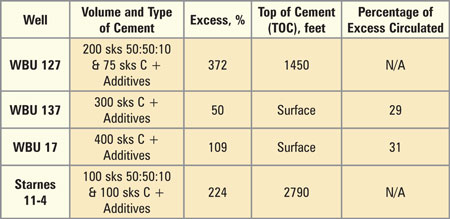

RUNNING CASING
The annular pressure or ECD increase caused by running casing with a float shoe was evaluated at various running rates. Four wells recently “re-cased” in West Texas were used for this evaluation. The drilling mud was displaced with water prior to running casing in each of the wells. Actual running rates varied from 0.5 ft/sec to 1.25 ft/sec (Table 5).

WBU 137 had a total annular clearance of 0.95 in. For this configuration, the equivalent velocity in the annulus resulting from viscous drag and fluid displacement is 2.4 times the downward velocity of the casing. The calculated ECD at TD of running the casing at 1 ft/sec is 9.04 ppg (Table 4), 8% higher than the 8.34-ppg density of the fresh water in the wellbore.
Starnes 11-4 had a total annular clearance of 0.45 in. For this configuration, the equivalent velocity in the annulus resulting from viscous drag and fluid displacement is over three times the downward velocity of the casing. At the same running rate of 1.0 ft/sec, this smaller annular space has a calculated ECD at TD of 15.45 ppg, an 85% increase in pressure over a static column of fresh water.
CASE HISTORY 1
WBU 127 was originally completed in 1997. The original casing had an OD of 4.5 in. and a weight of 9.5 lb/ft. According to the well files, the top of cement can be estimated to be at approximately 2,500 ft. Over the years, the casing has been corroded and developed leaks from 896 ft to 909 ft and from 1,444 ft to 1,508 ft. The corroded casing had a combined leak-off rate across the two intervals of 1.25 bpm at 1,300 psi. To resolve this problem and restore wellbore integrity, the operator ran a flush joint liner with an OD of 3.5 in. and a weight of 9.2 lb/ft to 5,148 ft.
The liner was cemented in place with 200 sacks of lead followed by 75 sacks of tail slurry. The lead was a 50:50 blend of Class C cement and fly ash with 10% bentonite, 5% salt and a dispersant mixed at a density of 11.8 ppg. This slurry had a yield of 2.45 cu ft per sack. The tail slurry was Class C cement with a fluid loss additive, 5% salt and a dispersant mixed at a density of 14.8 ppg. This slurry had a yield of 1.37 cu ft per sack. The total combined slurry volume was 592.75 cu ft. The calculated annular volume plus the 43-ft shoe joint was 127.81 cu ft; therefore, over 350% excess cement was pumped.

During the job, the surface treating pressure increased as expected (Figure 5). The annular pressures and ECD at the known weak casing depths were calculated using the dynamic modeling program previously described. The calculated pressures are given in Table 6 and plotted as ECD in Figure 6. As shown in Table 6, the ECD at the deepest known weak casing depth was over 26.27 ppg when the lead cement reached this depth. This high ECD can be attributed to the high friction pressure resulting from the 2.2 bpm displacement rate in a 3.5-in. by 4.09-in. annulus (Figure 1).


The pressure did not exceed the 4,380-psi burst pressure of the existing casing but was sufficient to break down the formation behind the weak points and increase the holes in the corroded sections. As a result, the TOC as indicated by a temperature survey after the job was at 1,450 ft, 6 ft below the top of the deepest casing leak. Cement did not cover the upper points of existing casing leaks, making this new casing susceptible to the same corrosion that created the problems in the first place.
Figure 7 illustrates what the dynamic model shows for ECD at a depth of 1,508 ft, based on the actual job. Figure 8 illustrates one scenario where the mix and pump rates of the cement and the displacement rate are reduced and have a subsequent reduction on the theoretical pressure applied at that depth. Another alternative to reduced pump rates is to reduce the densities of the slurries (Figure 9). Keeping the ECDs below the breakdown pressures of the intervals of bad casing will assist in raising the cement higher in the annular space. The other alternative is to use a smaller-size liner and increase the annular gap. The idea is seen in Figure 10, where the job is modeled as in Figure 7 but with the cement being placed in a larger annular space.



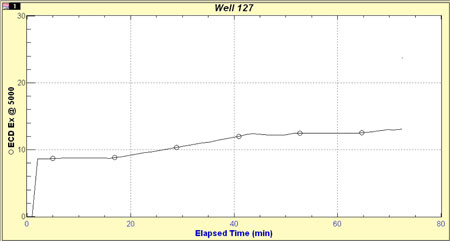
CASE HISTORY 2
The original J55 Grade casing in WBU 137 had an OD of 5.5 in. and a weight of 15.5 lb/ft. A casing inspection log was run from PBTD to surface. It showed severe internal corrosion below 4,100 ft, with holes at 4,364 ft, 3,900 ft and 1,850 ft. The decision was made to cement a 4-in. liner from surface to 5,097 ft. The liner was cemented in place with 300 sacks of Class C cement, with dispersant and fluid loss additives, mixed at a density of 14.8 ppg. The slurry yield is 1.33 cu ft per sack. The slurry volume was 399 cu ft. The annular volume was 236.35 cu ft, so the cement pumped was 69% in excess of what was required.

While cementing the liner in place at an average rate of 2.4 bpm, the surface pressure stayed below 1,200 psi (Figure 11). The calculated ECD across the corroded interval above 4,300 ft reached a maximum of approximately 17 ppg (Table 7 and Figure 12). The lower ECD compared with the previous case is due to the larger annular gap (0.95 in).
This resulted in an increase of the cross-sectional area by 90% over WBU 127. There were lower pressures, which resulted in the circulation of cement back to surface (34 sacks) and the isolation of the leaks in the old casing.


CASE HISTORY 3

A 5.5-in. OD and 14-lb/ft casing was used on WBU 17 as the original casing string. The operator decided to restore the pressure integrity of this well by cementing a 4.0-in. OD and 10.6-lb/ft liner from surface to 5,115 ft.
The calculated annular volume for this well is 254 cu ft. A total of 400 sacks of Class C cement with dispersant and fluid loss additives were mixed at a density of 14.8 ppg for this job. The slurry yield is 1.33 cu ft per sack. This resulted in a slurry volume of 532 cu ft, or an excess of 109%.
The liner job was displaced at an average rate of 3.5 bpm (Figure 13). The resulting surface pressure reached a maximum of 3,500 psi as shown in Figure 13. The annular ECD at the bottom liner reached a maximum of 17.83 ppg (Figure 14) while the mid-point of the liner reached a maximum of 17.71 ppg (Table 8). As in the case of WBU 137, the larger annular gap (1.015 in.) allowed for lower friction pressures and therefore less pressure applied to the existing wellbore, which resulted in approximately 84 sacks of cement being circulated to surface.


STIMULATION, ECONOMIC CONSIDERATIONS
Operator A’s Well 1, listed in Table 1, is an example of a well with a liner inside of an existing casing that is subsequently frac’ed in multiple stages in the Wolfcamp. Figure 15 is a plot of the cement job rate, pressure and density, and Figure 16 is the plot of of the ECDs at two depths. Figure 17 presents the rate, pressure and proppant concentration pumped on one of the fracture stages of the Wolfcamp formation in this well. Figure 18 compares how the friction pressure for the 25 bpm frac injection rate would vary depending on casing size. To pump the job down the 4-in. instead of the 5-in. casing means that the STP will be over 200% higher due to the increased friction. If the treatment is pumped down a 3.5-in. liner, the HHP requirement would be over 600% more. Figure 19 expresses this same information in terms of cost for the increased HHP, assuming that STP does not exceed 5,000 psi.



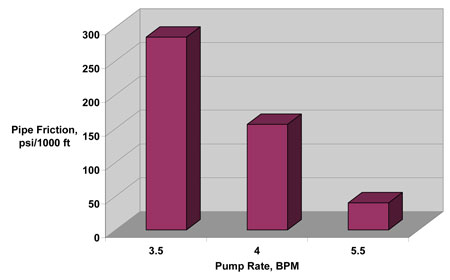
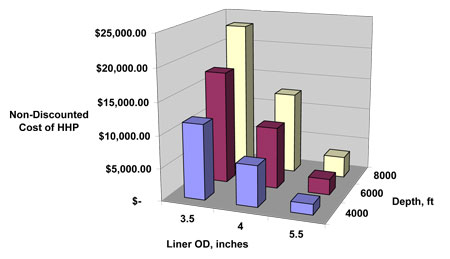
There has to be a risk-based balance with cementing costs. Figure 20 compares the non-discounted cement costs of four of the wells studied. Of these, 50% circulated cement to surface, but this cement circulated was on average 15.5% of the excess pumped. Changes in procedures, slurries and variance in annular gap in the wells studied over the last few years have yielded improvements (Table 9), but more needs to be done in designing future wells where re-casing is a necessity.
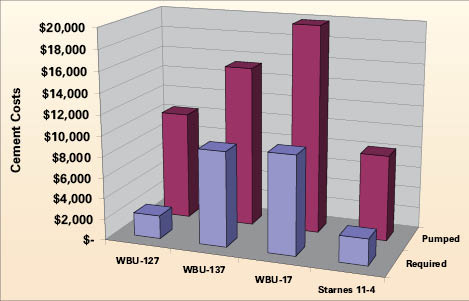
It is shown that when the annular gap was bigger and displacement rates were reduced, circulation of cement to surface was more common. However, as the annular gap was reduced, even slowing down displacement rates did not help to achieve circulation but did achieve a higher TOC.
CONCLUSIONS
1. Successful placement of cement in “re-cased” holes is dependent on pre-planning and pre-job modeling:

2. Assumptions that are normally valid in conventional cementing applications should not be used in narrow annulus re-casing applications. It is critical to analyze the cement job with a dynamic modeling program as part of the design process. Normal mixing and displacement rates may cause annular pressures to exceed casing burst or collapse strengths. A displacement rate as low as 1.0 bpm could cause downhole pressures to exceed formation or pipe limits.
3. High surge pressures can be caused by running casing at the “usual” rig rate. A dynamic modeling program may be used to determine the maximum annular fluid flow rate to avoid exceeding the casing burst or formation breakdown pressure behind the bad pipe. Once this is determined, a spreadsheet calculation may then be applied to determine how fast casing may be run to avoid exceeding this maximum annular rate.
4. Selection of liner OD and ID for re-casing existing wells is dependent upon a balance of costs and the physics of what will be done in the future in the area of stimulation. The choice of single-zone, multizone or limited-entry stimulation and the associated pump rates can all be significantly impacted by the flush joint liner design.
Acknowledgment: The authors wish to thank BJ Services Company USA, and Walsh Petroleum for allowing them to present this information. They would also like to thank Gerald Benton and Dean Olson with BJ Services and Robert Meritt with Walsh Petroleum for their assistance in gathering information.
This article is based on SPE 124381, “Wellbore Re-entries and Repairs: Practical Guidelines for Cementing New Casing Inside Existing Casing,” copyrighted by SPE and presented at the 2009 SPE Annual Technical Conference and Exhibition, held in New Orleans, La., 4–7 October.
References:
1. Purvis, D.L. and Gregory, G.:”Utilizing A Field Computer System During Cementing to Help Avoid Costly Workovers”; CIM 88-39-47; Journal of Canadian Petroleum Technology, Sept. 1990.
2. Purvis, D.L. and St. Clergy J.:”Eliminating the Unknowns of Primary Cementing With On-Site Verification and Post Job Analysis”; SPE 23991; Permian Basin Oil and Gas Recovery Conference, Midland Tx. March 18-20, 1992.
3. Purvis, D.L. and Smith, D.D.: “Real-Time Monitoring Provides Insight to Flow Dynamics During Foam Cementing”; SPE 24570; Annual Technical Conference, Washington D.C., October 4-7, 1992.
4. American Petroleum Institute: ”Recommended Practice for Testing Well Cements”; API RP 10B-2 First Edition July 2005, API Publishing Services, Washington DC: API.
5. Fontenot, J.E and Clark, R.K.:”An Improved Method for Calculating Swab and Surge Pressures and Circulating Pressures in a Drilling Well”; SPE 4521, SPEJ (October 1974) 451-62.
6. Mitchell, R.F.:”Surge Pressures in Low-Clearance Liners”; IADC/SPE 87181; IADC/SPE Drilling Conference, Dallas Tx, March 2-4 2004.
7. Rubiandini, R.S.:”New Formula of Surge Pressure for Determining Safe Trip Velocities”; SPE 64480; SPE Asia Pacific Oil & Gas Conference, Brisbane Australia, October 16-18 2000.
8. Bern P.A., Morton E.K., Zamora M., May R., Moran D., Hemphill T., Robinson L., Cooper I., Shah S., Flores D.V.: ”Modernization of the API Recommended Practice on Rheology and Hydraulics: Creating Easy Access to Integrated Wellbore Fluids Engineering”; SPE 98743, SPE Drilling and Completion (September 2007) 197-204.
9. RP 13D, Recommended Practice on Rheology and Hydraulics of Oil-well Drilling Fluids, fifth edition 2006, Washington, DC: API.
10. Cramer, D.D.:”Application of Limited Entry Techniquesin Massive Hydraulic Fracturing Treatments,” SPE 16189, SPE Production Operations Symposium, March 8-10, 1987, Oklahoma City.





Why is cement identified as the only way of filling the annular space?
Isn’t an elastomeric seal more effective? (eliminating the problem of cement going into the pay zone)?